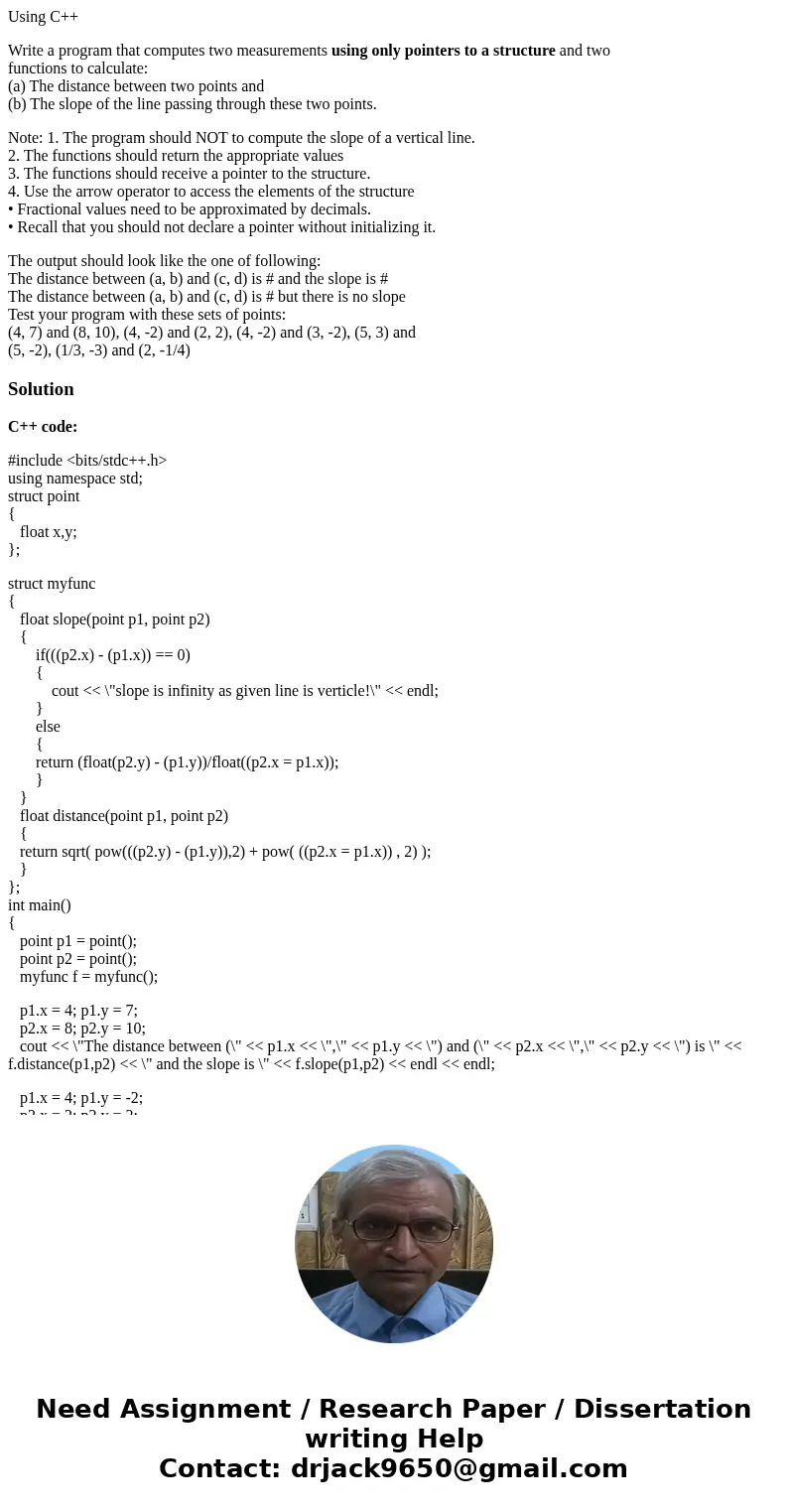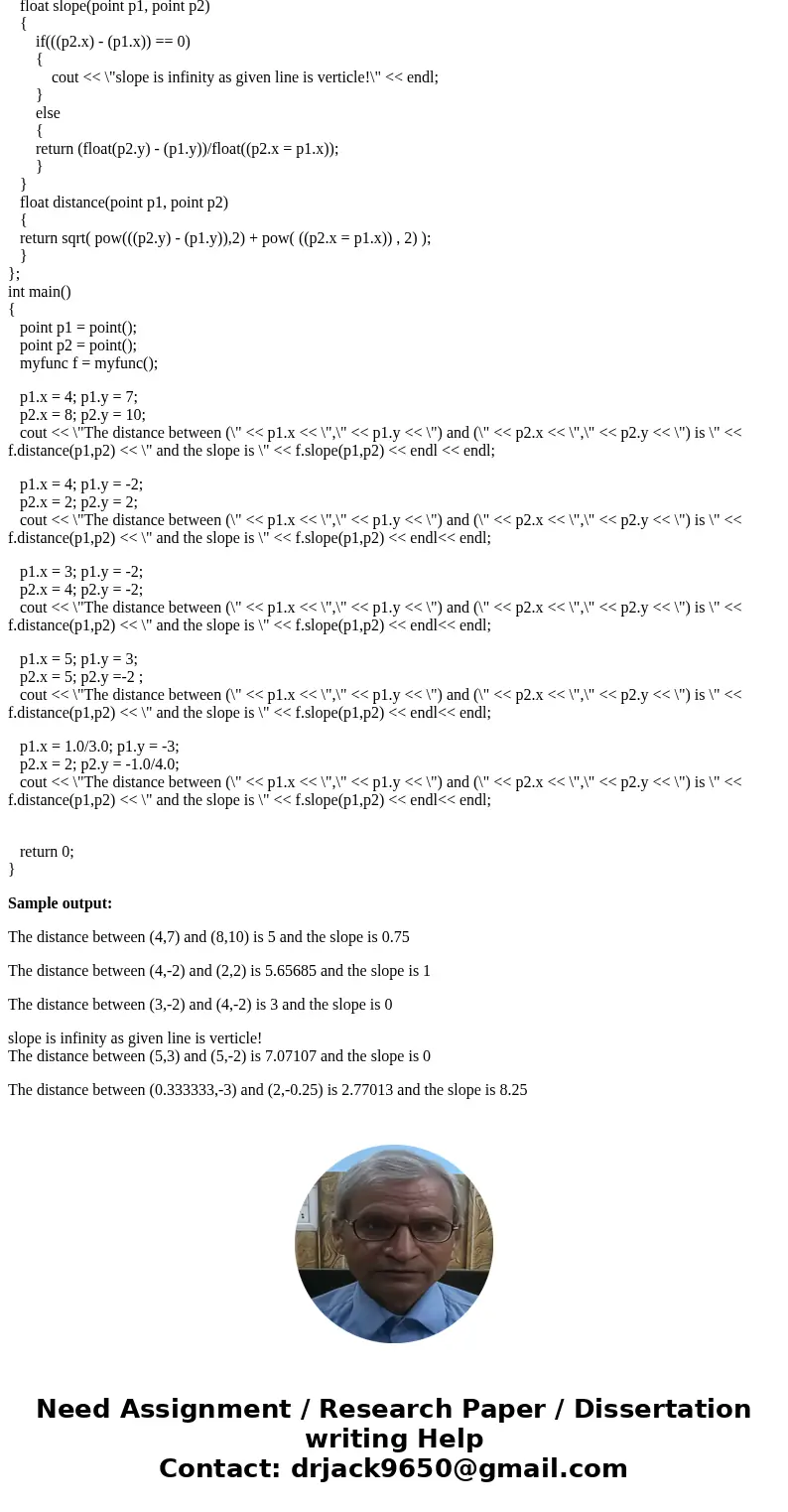Using C Write a program that computes two measurements using
Using C++
Write a program that computes two measurements using only pointers to a structure and two
functions to calculate:
(a) The distance between two points and
(b) The slope of the line passing through these two points.
Note: 1. The program should NOT to compute the slope of a vertical line.
2. The functions should return the appropriate values
3. The functions should receive a pointer to the structure.
4. Use the arrow operator to access the elements of the structure
• Fractional values need to be approximated by decimals.
• Recall that you should not declare a pointer without initializing it.
The output should look like the one of following:
The distance between (a, b) and (c, d) is # and the slope is #
The distance between (a, b) and (c, d) is # but there is no slope
Test your program with these sets of points:
(4, 7) and (8, 10), (4, -2) and (2, 2), (4, -2) and (3, -2), (5, 3) and
(5, -2), (1/3, -3) and (2, -1/4)
Solution
C++ code:
#include <bits/stdc++.h>
using namespace std;
struct point
{
float x,y;
};
struct myfunc
{
float slope(point p1, point p2)
{
if(((p2.x) - (p1.x)) == 0)
{
cout << \"slope is infinity as given line is verticle!\" << endl;
}
else
{
return (float(p2.y) - (p1.y))/float((p2.x = p1.x));
}
}
float distance(point p1, point p2)
{
return sqrt( pow(((p2.y) - (p1.y)),2) + pow( ((p2.x = p1.x)) , 2) );
}
};
int main()
{
point p1 = point();
point p2 = point();
myfunc f = myfunc();
p1.x = 4; p1.y = 7;
p2.x = 8; p2.y = 10;
cout << \"The distance between (\" << p1.x << \",\" << p1.y << \") and (\" << p2.x << \",\" << p2.y << \") is \" << f.distance(p1,p2) << \" and the slope is \" << f.slope(p1,p2) << endl << endl;
p1.x = 4; p1.y = -2;
p2.x = 2; p2.y = 2;
cout << \"The distance between (\" << p1.x << \",\" << p1.y << \") and (\" << p2.x << \",\" << p2.y << \") is \" << f.distance(p1,p2) << \" and the slope is \" << f.slope(p1,p2) << endl<< endl;
p1.x = 3; p1.y = -2;
p2.x = 4; p2.y = -2;
cout << \"The distance between (\" << p1.x << \",\" << p1.y << \") and (\" << p2.x << \",\" << p2.y << \") is \" << f.distance(p1,p2) << \" and the slope is \" << f.slope(p1,p2) << endl<< endl;
p1.x = 5; p1.y = 3;
p2.x = 5; p2.y =-2 ;
cout << \"The distance between (\" << p1.x << \",\" << p1.y << \") and (\" << p2.x << \",\" << p2.y << \") is \" << f.distance(p1,p2) << \" and the slope is \" << f.slope(p1,p2) << endl<< endl;
p1.x = 1.0/3.0; p1.y = -3;
p2.x = 2; p2.y = -1.0/4.0;
cout << \"The distance between (\" << p1.x << \",\" << p1.y << \") and (\" << p2.x << \",\" << p2.y << \") is \" << f.distance(p1,p2) << \" and the slope is \" << f.slope(p1,p2) << endl<< endl;
return 0;
}
Sample output:
The distance between (4,7) and (8,10) is 5 and the slope is 0.75
The distance between (4,-2) and (2,2) is 5.65685 and the slope is 1
The distance between (3,-2) and (4,-2) is 3 and the slope is 0
slope is infinity as given line is verticle!
The distance between (5,3) and (5,-2) is 7.07107 and the slope is 0
The distance between (0.333333,-3) and (2,-0.25) is 2.77013 and the slope is 8.25


 Homework Sourse
Homework Sourse